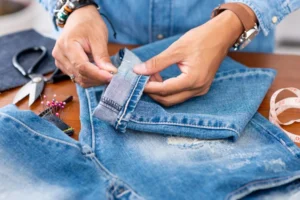As the fashion industry continues to evolve and become more conscious of its environmental impacts in recent years, terms such as “sustainable” and “ethical” fashion have become increasingly prevalent within the ranks of shoppers. But what exactly is meant by these terms?
In this blog post, we’ll explore the key differences between ethical and sustainable fashion as well as why it’s so important for you to make an informed decision when shopping for apparel. We’ll also touch on some tips that can help you determine which type of clothing is right for your wardrobe. So if you’re looking to build a closet full of garments that not only look good but feel good too, keep reading!

Fashion industry and its environmental and social impacts
The fashion industry is a giant global business that greatly impacts our economy and communities. However, the industry’s rapid production rates, low prices, and lack of regulation have caused alarming environmental and social impacts.
The rise of fast fashion has led to a culture of disposable clothing, with garments often made from synthetic materials that release harmful toxins when produced and worn. In addition, the fashion industry is known for exploiting cheap labor in developing countries, leading to poor working conditions and wages.
To address these issues, many sustainable fashion brands have emerged, focusing on ethical and eco-friendly production practices. By supporting these brands and raising awareness about the negative impacts of the fashion industry, we can work towards a more sustainable and equitable future.
Definition of ethical and sustainable fashion
Fashion is more than just clothes on a hanger; it has the power to make a statement and create change.
Ethical and sustainable fashion is an approach to clothing design and production that is mindful of the social and environmental impact. Ethical fashion ensures workers in the supply chain are treated fairly with fair wages and safe working conditions. Meanwhile, sustainable fashion considers the entire lifecycle of a garment, from the materials used to its disposal, to minimize negative environmental effects.
Together, ethical and sustainable fashion focus on creating clothing that does not compromise either human rights or environmental health. It allows us to make intentional choices as we clothe ourselves and contribute to a better world.
Advantages of ethical and sustainable fashion
Nowadays, ethical and sustainable fashion is becoming more and more popular. The advantages of supporting this movement are numerous. First, ethical fashion promotes fair labor practices and wages for workers. This means that supporting ethical and sustainable fashion helps to ensure that producers are treated with dignity and respect, which makes for a better overall industry.
Additionally, sustainable fashion focuses on reducing environmental impact through the use of eco-friendly materials and practices. This helps to preserve natural resources and decrease pollution. In short, ethical and sustainable fashion is not only stylish, but also beneficial for the planet and its inhabitants. By supporting this movement, we can help create a better future for all of us.
Exploring the materials used in ethical and sustainable fashion
As our understanding and appreciation for ethical and sustainable fashion continues to grow, one aspect that often goes unnoticed is the materials that go into making these garments. From innovative fabrics made from recycled materials to natural fibers that minimize harm to the environment, exploring the materials used in ethical fashion provides an intricate and fascinating look into the world of sustainable fashion.
Not only do these materials embody the values of sustainability and social responsibility, but they also boast superior quality and durability, making them a worthy investment for any conscious shopper. So next time you’re browsing for new additions to your wardrobe, take a moment to consider the stories behind the fabrics we wear.
The process of production for ethical and sustainable fashion
The fashion industry has never been one to shy away from criticism, especially when it comes to the ethics of production. But amidst the growing concerns about the impact of fast fashion on both people and the planet, a new wave of designers is emerging, committed to doing fashion differently.
The process of producing ethical and sustainable fashion is not an easy one, as it requires a complete overhaul of traditional methods. Instead of prioritizing profit, these designers focus on fair labor practices, reducing waste and using environmentally-friendly materials.
From sourcing to manufacturing, every step is carefully considered to ensure that the end result is not only beautiful but also environmentally responsible. While still a small fraction of the industry as a whole, the growing popularity of ethical and sustainable fashion shows that consumers are becoming more savvy and demanding when it comes to their clothing choices.

The importance of transparency in the industry
Transparency is becoming increasingly important in every industry. The world is moving towards a more interconnected and informed state, and consumers have started to demand more honesty from companies. Being transparent means being upfront about everything, from the products or services you offer to the price you charge.
It demonstrates respect for your customers and builds trust in your brand, which leads to a stronger relationship between you and your audience. Furthermore, transparency may attract a new customer base that is interested in supporting companies with integrity. In sum, transparency is more than just a buzzword – it’s an essential element for success in the modern business environment.
Last Word
As we’ve seen, ethical and sustainable fashion has gained attention in the recent years due to its environmental and social benefits. By valuing people, planet and product, this type of fashion offers practical solutions to help reduce waste, pollution, and animal suffering.
With more companies now having access to innovative technology and materials, ethical and sustainable fashion continues to grow in popularity worldwide. Additionally, transparency is essential for brands that wish to make ethical decisions and ensure proper labor practices in their supply chains.
It is up to us as consumers to do our research when it comes to supporting these businesses by refusing unsustainable or unethical practices within fashion industry. With conscious effort from both individual buyers and business owners alike, we can all work together towards making a positive impact on our environment while keeping style at the forefront of modern trends.
Frequently Asked Questions
Consumers can support ethical and sustainable fashion by choosing brands that prioritize these principles, buying high-quality and durable clothing, opting for second-hand items, and being conscious of their overall fashion consumption.
Yes, several certifications exist to identify ethical and sustainable fashion brands, such as Fair Trade, Global Organic Textile Standard (GOTS), and the Ethical Trading Initiative (ETI).
Some challenges include higher production costs for sustainable materials, finding suppliers that meet ethical standards, and educating consumers about the importance of supporting these practices.



